 |
||
|
||
| ||
Heat pipes, fostered in the interior of defense departments, have had a long painful journey to regular PCs. Due to their remarkable thermal characteristics these advanced cooling devices were constantly used in various electronic systems, but the distressful PCs were not in the area of their interest. During the reign of "386" and "486" PCs the expedience of computer-oriented adaptation of heat pipes was mildly speaking doubtful, no questions here. However already with Intel Pentium II processors these heat pipes could have cut a balanced tandem. But the impression those days was that no one in the computer industry heard anything about them. The turning-point is year 2000, when one of the leading wizards of cooling systems, the Cooler Master company, loudly announced the heat pipes having launched a historic cooler – CH5-HK11. Frankly speaking, this product was not that stunning, but at least it was something, and this "something" coped well with its direct responsibilities. The first step is the hardest! The new technology trend started to gradually puck up speed: Cooler Master went on perfecting its skills on top coolers, equipping them with heat pipes, other vanguard cooler manufacturers did not leave it unanswered either. The number of activists in the "heat pipes support group" was growing day by day, it constantly recruited industry war-horses as well as many promising "youngsters" (Gigabyte, Zalman, Thermaltake, Thermalright, GlacialTech, Spire, …lest I forget none, to avoid any abuses). This summer, having gained the "critical mass" of popularity, these technologies became no less than the main propelling force of the cooler industry – practically all advanced novelties of the season are based on heat pipes. So, today we'll carry out a qualification examination of the three brightest representatives of the new galaxy of high end coolers – Cooler Master Hyper 6, Gigabyte 3D Cooler-Ultra, and Thermaltake Silent Tower. Let's see what interesting solutions they can offer to consumers and check how good these models are in practice. Ready, steady, go! Onward to records! Cooler Master Hyper 6 (KHC-V81-U1)Say what you like, but properly majestic, truly charismatic coolers, which can pierce you through and through so that the heart of a computer enthusiast would suddenly flame with passion to possess this engineering wonder, and he would be ready to accept the new cooling "messiah" in awe, rarely appear on the market. Perhaps, having rummaged the contemporary history since about 1996, such coolers can be counted on the fingers of one hand. However to the joy of enthusiasts, their small company is not already limited to relic products only: this summer, after a long slack, the "annals" of cooling systems are at last replenished with a new epoch-making cooler! Its name is Cooler Master Hyper 6. 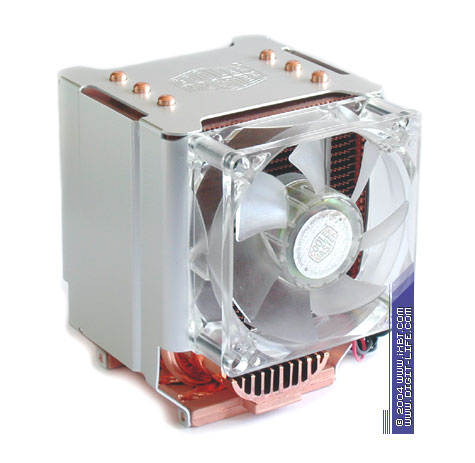 What a handsome! It's got everything – chic, brilliance, and great power of advanced technologies! It should be noted that the last aspect is really tumid and absolutely matches the marketing name of the cooler: Hyper 6 is based on a superb in its thermal power heatsink (dimensions: 85x70x115 mm), designed according to classical canons of heat pipe technologies but with several modifications and adjustments. The cooler is based on six copper heat pipes (6mm in diameter) and a section of copper heat-dissipating fins 0.3mm thick (all in all 27 fins!). An auxiliary copper heatsink 83x45x27mm fixed to the base of this combined construction serves as an additional bonus providing high-intensity heat dissipation from the hottest parts of heat pipes. Thus, the total heat exchange area is about 3800 cm2, which rides a record – these days no other solid copper monster can boast of such parameters. 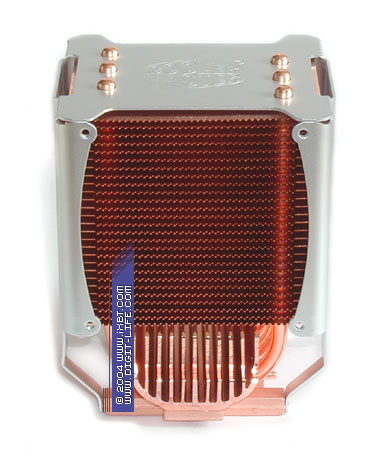 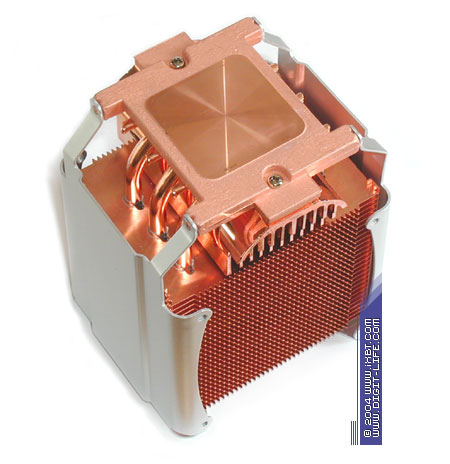 As we already noted in the article about Gigabyte PCU21-VG, the classical approach to designing cooling systems based on heat pipes entails several problems, which may lead to a serious reduction of their thermal efficiency. To the credit of specialists in Cooler Master, these reefs were safely evaded: plate finning in Hyper 6 has an increased fin spacing (3 mm), which promotes the friction loss of the heatsink and thus intensifies the heat exchange. Another important technical issue – all joints between the heat pipes and the base, auxiliary heat sink and the plate finning in Hyper 6 are honestly welded, no hack-work. Optimized contact thermal resistance is 100% guaranteed here! A good impression is produced not only by the heat sink, but by the cooler bundle as well: Hyper 6 is bundled with a whole kit and caboodle, which includes a good fan of the standard size 80x80x25 mm (Protechnic MGT8012HS-T25) equipped with an RPM monitor (rotation speed of the impeller may vary in the range from 2000 to 3000 rpm), a 3.5-inch bay faceplate and a PCI bracket for a fan speed dial, a custom retention bracket (for Socket 478 and Socket 754), thermal paste, and user's manual. 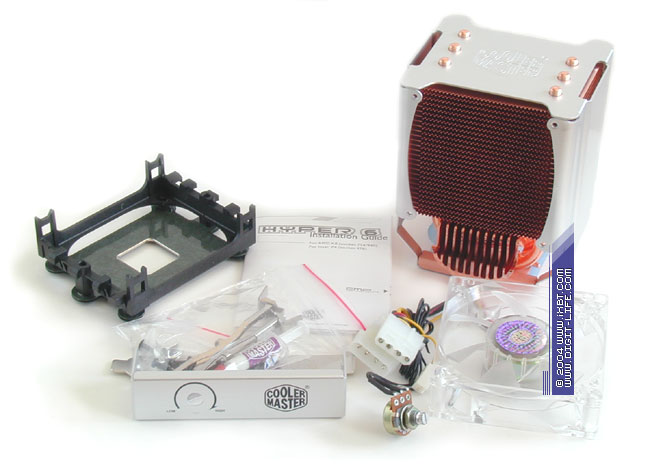 At the same time, Hyper 6 is not that brilliant at its performance. The first nuance, being a direct result of its design philosophy, is its weight, which is about 950g. It's more than twice the standard weight! Though this burden is still far from critical to be frank, it wouldn't be superfluous to be extra careful when installing the cooler and when manipulating the system block (portage, etc). Another tricky nuance is the Hyper 6 installation process itself. Manipulations with both Socket 754 and Socket 478 will give you a lot of trouble: you would have to install a special retention module (comes shipped in the bundle) and it naturally cannot be done without removing a mainboard (as well as all attendant innards). Besides, stiff clips pour oil on the fire: it'll be hard to tame them without using a screwdriver or other improvised means. Unfortunately, you cannot expect a free and easy installation from Hyper 6. Nevertheless, all these installation shortcomings look insignificant against the impressive results demonstrated by Hyper 6 set to work. Our hero is especially good at maximum fan speed (3000 rpm). It easily outscores its competitors, keeps a civil noise level, and conquers the title of an absolute champion of our today's competition. Operating in the low-speed mode (2000 rpm), Hyper 6 does not take a back seat either. In thermal terms it outscores another strongest modern athlete – Gigabyte 3D Ñooler-Ultra, and demonstrates the highest efficiency and excellent noise ergonomics. Even without a forced air flow as such (that is operating without a fan, with no noise) the cooler still demonstrates high efficiency and successfully competes with many other decent coolers. Truly fantastic efficiency! As a result, if you blink at the installation shortcomings, Hyper 6 can be easily called Zeus on today's Olympus of cooling systems: out of those coolers available on the Russian market, it has no equal in terms of thermal efficiency. Bravo, Cooler Master, that's the right spirit! Well, let's move on. A next contender is the top cooler from Gigabyte cooling devices – vanguard 3D Cooler-Ultra. Gigabyte 3D Cooler-Ultra (PCU31-VH)From the look of it, the new 3D Cooler-Ultra inherits all family traits of its ancestor 3D Cooler-Pro and offers the same innovative fellowship of heat pipes and a block of heat-dissipating fins, finished with a powerful centrifugal fan 80x60 mm. The only innovation here is the use of copper instead of aluminium: finning of the heat-release surface of the heat sink is now formed by a section of 44 copper fins 0.3 mm thick. But the general idea of the cooler is still the same. 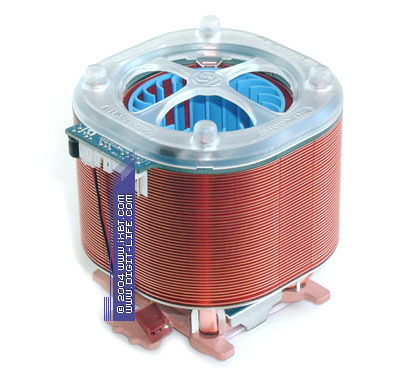 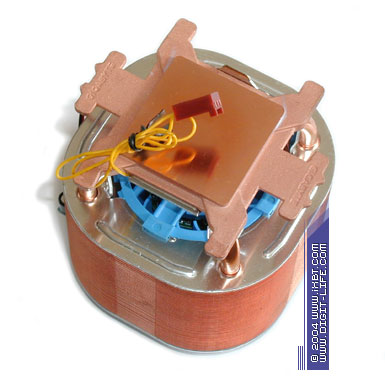 The bundle of 3D Cooler-Ultra also suffered no significant changes: the cooler is again spiced up with a very convenient universal retention module (Socket 478, Socket A and Socket 754/940), a special power cable, a fan speed control and a 3.5" front panel, an additional PCI Rear Panel for the fan speed control, thermal paste, and a user's manual including a detailed description in Russian. 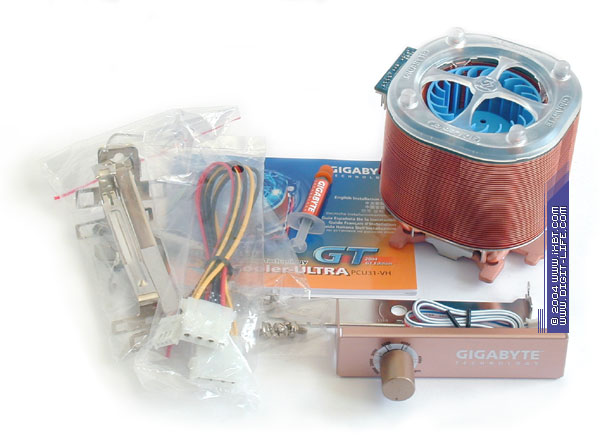 It's all good, sure. But we know that the only combination of copper and rich bundle, even with a touch of advanced technologies, cannot always solve thermal problems. We have learned that many times: take for example the classical Thermaltake Volcano 11+. Fortunately, after a thorough analysis of 3D Cooler-Ultra, all our pessimistic feelings about it have been gone: in practice, the new cooler has not only a better look, but also improved "internal affairs". The main gain of 3D Cooler-Ultra is the optimized thermal contact of heat pipes and the copper finning: welding is used instead of thermal clue here, good old welding of high quality. This apology for "modernization" (exactly in inverted commas, it's quite obvious that Gigabyte specialists should have thought about it earlier) puts everything in its place. In the low-speed mode, operating at 2000 rpm, 3D Cooler-Ultra already starts to demonstrate very high thermal efficiency, heavily outscoring its pacified ancestor 3D Cooler-Pro and supplementing this result with a pleasant noise ergonomics. The cooler also gets ahead in the medium-speed mode (3400 rpm). Having retained the civil noise level, it is practically on the level with the former champion Zalman CNPS7000A-Cu. But the best thermal efficiency is reached by 3D Cooler-Ultra at maximum rpm (4800 rpm). Here it is outscored only by Cooler Master Hyper 6 (however this efficiency costs pretty much – in this mode the cooler gains the second "prize-winning" place in the noise level, almost catching up with the loud Thermaltake Spark 7+). Look, they can do it when they want to: the "little" 3D Cooler-Ultra in fact turns out a very promising product! Summing up its excellent thermal efficiency, good noise ergonomics in moderate modes, and friendly installation, we get a nice combination of technical features. With more spirit and heavier build it would have surely achieved new records! Be daring, Mr. Gigabyte! And now it's time to have a look at the third contender – the giant cooler Thermaltake Silent Tower. Thermaltake Silent Tower (CL-P0025)The body of Silent Tower is really huge, no exaggerations. It's even bigger than the giant Hyper 6: powerful heatsink 86x80x138 mm consisting of three copper heat pipes 6 mm in diameter and a section of 59 aluminium heat-dissipating fins 0.2 mm think, as well as an enlarged fan (90x90x25 mm) look impressive and authoritative.  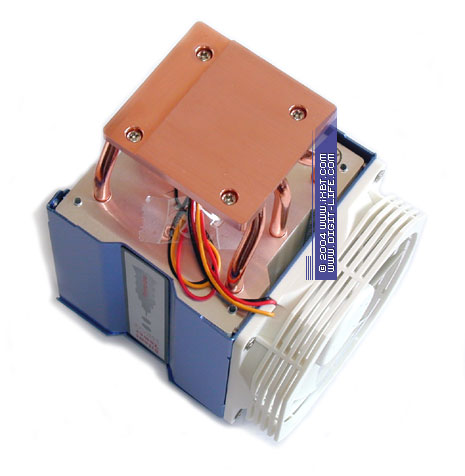 Though the bundle of Silent Tower is not that replete as those of Hyper 6 and 3D Cooler-Ultra (it lacks the fan speed controller), this cooler demonstrates no lesser universality: it's retention module is compatible with four relevant platforms: Socket A, Socket 754/940/939, Socket 478, and Socket T. But to call it ergonomic is the utmost of unreason: any installation, no matter for what socket, requires removing the mainboard from the PC case and then a lot of intensive passes with periodic diligent manipulations with a screwdriver (mounting screws fixing Í-shaped brackets will have to be operated with extra care – they control the pressure, and your task is not to overdo them to avoid skewness or worse). However, to do justice to the retention module we should note: in practice this obscure mounting system is much more secure than the mounting hardware in Hyper 6. In any conditions the cooler sits fast on the socket, no matter what you do with the system block – pound it, kick it, throw it out of the window from the second floor. :) 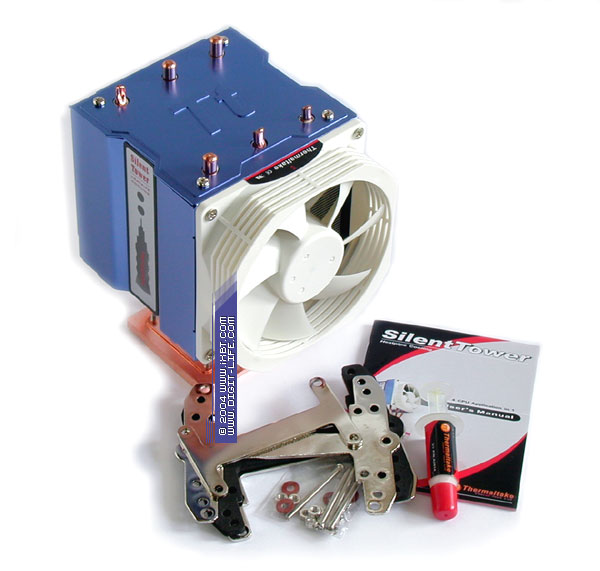 Thermal stuff in Silent Tower is also very interesting: the cooler demonstrates an extremely developed finning (a section of 59 fins 86x80 mm, beaded on the heat pipes at 1.5 mm steps), which possesses the record dissipation area (about 7500 cm2!). Such dense spacing of the fins has a bad impact on hydraulics of the heat sink – it gets very difficult to blow through. 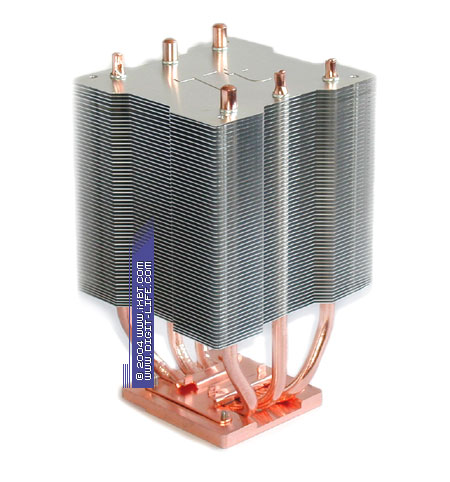 But Silent Tower found a simple but effective resolution for this problem: instead of a "classic" axial fan the cooler uses an enlarged vanguard fan with the "grid" design of the housing and aggressive aerodynamic configuration of the impeller (Everflow F129025DM, a copy of the familiar Panasonic Panaflo fans). Due to high quality rigging, at 2600 rpm F129025DM "generates" quite respectable values of air flow and static air pressure, which ensure decent blowing through the dense finning and provide good conditions for intensive heat dissipation. Meantime, this cooler does not manage to realize its thermal potential to the full extent. The cooler is betrayed by a little but harmful issue: instead of good old welding, the heat pipe and fins are joined with regular thermal glue, which significantly degrades the quality of their thermal contact. As a result, the most powerful finning of Silent Tower does not work to its full capacity, and only the well tuned tandem of the fan and the heat sink allows to pull its efficiency to the high end level. If this cooler had been more attentive to details, we could have been expecting truly remarkable efficiency from it. So, we have just examined all the three contenders of our today's shootout. Let's see the results! Test resultsLet's start with the results of the thermal efficiency tests of the coolers in our special testbeds. Testbed Configuration 1:
To emulate the maximum thermal load we use the burnk7 utility from CPUBurn. Motherboard Monitor is used to control the temperatures. Testbed Configuration 2:
To emulate the thermal load we use the burnp6 utility from CPUBurn (two instances of the program are started, to use the second "virtual" processor, Hyper-Treading technology). The proprietary utility System Guard from Fijitsu Siemens Computers is used to control the temperatures. Testbed Configuration 3:
To emulate the thermal load we use the burnk7 utility from CPUBurn. System Guard from Fijitsu Siemens Computers is used to control the temperatures. Here is what the test results look like: Diagram 1. Temperature readings (Socket A) Notes Diagram 2. Thermal resistance (Socket A)
Diagram 3. Temperature readings (Socket 478) Notes Diagram 4. Thermal resistance (Socket 478)
Diagram 5. Temperature readings (Socket 754) Notes Diagram 6. Thermal resistance (Socket 754)
And finally, here are the results of noise measurements (to learn about this method, read the article "Noise characteristics of coolers and methods of measuring noise levels"). Diagram 7. Noise characteristics
To all appearances, no comments are necessary. Let's draw the bottom line! ConclusionsThe cooler industry still has plenty of shot in the locker! Despite numerous writings on the wall, air cooling is still on top! Dramatic confirmation to it is the trinity of top models – Cooler Master Hyper 6, Gigabyte 3D Cooler-Ultra and Thermaltake Silent Tower – brilliant representatives of the new generation of hi end cooling systems. 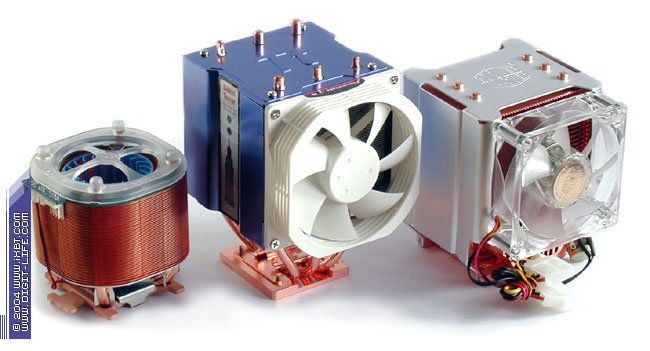 They are the best coolers in their class for today: possessing the highest efficiency, they can provide ergonomic cooling of even the hottest CPUs. Cooler Master Hyper 6 shines out amid them – a real master of its trade, it demonstrates stunning efficiency and can be a serious competitor to vanguard water cooling systems. Well, we wish the leaders of this industry new achievements and every success! What concerns us, we'll be watching closely the contours of things at this front.
Thermaltake Silent Tower has been kindly provided by Thermaltake
Vitaly Krinitsin (vit@ixbt.com) September 27, 2004 Write a comment below. No registration needed!
|
Platform · Video · Multimedia · Mobile · Other || About us & Privacy policy · Twitter · Facebook Copyright © Byrds Research & Publishing, Ltd., 1997–2011. All rights reserved. |